 [With the debate over income inequality raging as the presidential campaign lurches into full swing, and virtually all current and former Republic Party presidential candidates — Donald Trump, Ted Cruz, Marco Rubio, John Kasich, Jeb Bush — calling for the curtailing or elimination of the U.S. Department of Agriculture’s Supplemental Nutrition Assistance Program (SNAP) program, I thought I’d recount my own relatively recent experiment with the food budget allocated under SNAP, known colloquially as food stamps. (So-called, for those of the younger persuasion, because they originally came in the form of tear-out coupons in little booklets. Nowadays your monthly allotment gets transferred electronically to a debit card. For more about the current program, visit the USDA site or FoodStamps.org.)
[With the debate over income inequality raging as the presidential campaign lurches into full swing, and virtually all current and former Republic Party presidential candidates — Donald Trump, Ted Cruz, Marco Rubio, John Kasich, Jeb Bush — calling for the curtailing or elimination of the U.S. Department of Agriculture’s Supplemental Nutrition Assistance Program (SNAP) program, I thought I’d recount my own relatively recent experiment with the food budget allocated under SNAP, known colloquially as food stamps. (So-called, for those of the younger persuasion, because they originally came in the form of tear-out coupons in little booklets. Nowadays your monthly allotment gets transferred electronically to a debit card. For more about the current program, visit the USDA site or FoodStamps.org.)
Part 1 of this post appears below; click here for Part 2. — A. D. C.]
•
Eating Well on Food Stamps
My wife Anna and stepson Jacky left on an extended trip to China on January 11, 2013, several years into the Great Recession. With their departure, I found myself shopping and cooking for one for the first time in quite a while. I’d never tracked my food costs previously, but with right-wing indignation over all such “entitlements” much in the news I decided to take the opportunity afforded by the absence of Anna and Jacky to see how well I could subsist by myself on the average SNAP allowance for a single person at that time, $140 a month — my version of the “food stamp challenge.”
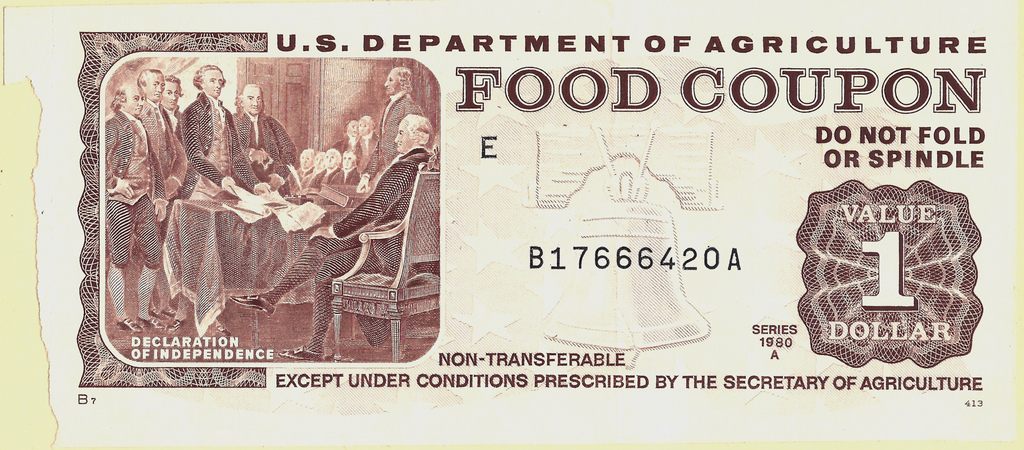
$1 food stamp coupon, 1980
That doesn’t sound like much, especially in today’s economy. I had read and heard constantly about how difficult it is to eat — and especially to eat well, meaning not just pleasurably but in a healthy, nourishing way — on the standard SNAP allotment. Since I continue to work, and generate income, I decided not to rely entirely on that allotment, but — as many working people do — to augment it, by adding $40 a month, giving me a total of $180 monthly with which to work, an average of $6 per day.
•
Our neighborhood, Stapleton, on the North Shore of Staten Island (just a few blocks away from where a homicidal policeman killed Eric Garner in July of 2014), does not offer much in the way of shopping. It’s not a food desert, but it’s not a food oasis either. We have no bakery, only a few small grocery stores, and only a few specialty food stores (these mostly sell African, Caribbean, and Latin American items).
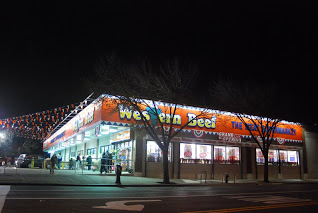
Western Beef, Bay Street, Staten Island
Within walking distance we have one mediocre supermarket, a Western Beef branch (with the emphasis on large portions of meat, as the name suggests); Bay Street Bazaar, a Mexican bodega; a then-recently opened branch of Deals (which closed this past January, soon to be replaced by a Family Dollar outlet) and a more recently opened branch of Family Dollar (soon to be replaced by a Dollar Express outlet), both of which offered a small assortment of packaged and frozen foods; and Dinora’s Meat Market, a small eastern European halal butcher which also sells olives, feta and other cheeses, Bulgarian yogurt, assorted canned, bottled, and packaged foods, plus a few other things.
A longer walk away there was a more upscale supermarket, the Waldbaum’s in Rosebank (recently closed, the fate of its site uncertain). Even further, ten minutes by bus, there’s Top Tomato, a better supermarket, and, across the street from it, Montalbano’s, selling Italian specialties. Half an hour away by bus in another direction, on Hylan Boulevard, there’s Tastebud’s, a health-food store. When they’re here, once every week or so Anna and Jacky head to Chinatown in Manhattan to stock up on tofu, frozen dim sum, Chinese veggies, and other items. Unless I happened to find myself in or near one of those areas, I decided, I’d restrict myself to what I could find and bring home on foot within a roughly six-block radius.
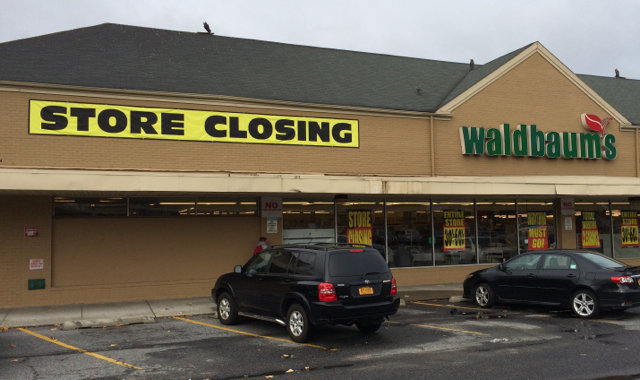
Waldbaum’s, Rosebank, Staten Island, closing, 2016
For those in the SNAP program, the neighborhood also offers three local food pantries plus City Harvest, which distributes free produce to those who qualify. One allows twice-weekly usage, the other two a once-a-month haul. My visits to these, for informational purposes, showed that one could stock up on staples there: flour, breakfast cereals, pasta, rice, fruit juices, canned soups and vegetables, dried beans and chickpeas, and fresh baked goods — including excellent bread. One of these, after its twice-weekly distribution sessions for SNAP recipients. puts the leftover fresh bread outside for anyone to take. Donated by such sources as Trader Joe’s and Whole Foods, this is the best bread in the neighborhood; I availed myself of it then, and have done so periodically ever since.
The pantries offered some fresh vegetables and fruits, mostly the least perishable: white and sweet potatoes, carrots, butternut squash, cucumbers, onions, apples. City Harvest did the same. I ran my experiment in winter; perhaps in warmer weather the offerings multiply, and include more fruits and green veggies.
•
We eat very well, by our own standards, enough so that we prefer our own cooking to restaurant food. But we prepare more elaborate meals to consume ensemble than any of us would when eating solo. Part of my test, then, involved seeing whether I could maintain a high quality for the meals without spending a lot of prep time on them. This would lead me to the inclusion of a few more frozen foods, and more use thereof, than usual.
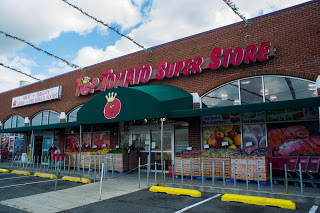
Top Tomato, Rosebank, Staten Island
I established a simple set of ground rules. I’d track all my food consumption for three months, January 15-May 15, making a meal-by-meal list. I’d track all food purchases during that period. If I used a foodstuff that we already had in the larder, I’d treat it as if freshly purchased and opened, and log it in as such. Thus some of the meals might draw, in whole or in part, on previously purchased ingredients and materials, but their cost would get ascribed to those months’ budget. (Coincidentally, at the time Anna and Jacky left on their trip we had used up almost all previously prepared dishes — extra portions of stews and soups that we’d frozen. So I had no MREs whose cost I could not ascribe.)
By the same token, I bought items during that period that lasted and got used well past the end date of my experiment, but whose full cost I logged in on my spreadsheet. So I erred on the side of full payment for everything used in that period, even if previously purchased, as well as everything purchased during that period, even if it didn’t get entirely used up.
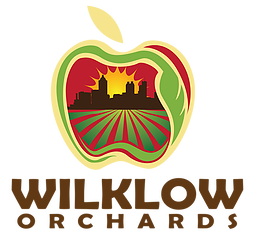 This even included vegetable and herb sets from Wilklow Orchards, an upstate New York vendor that sets up shop in the Manhattan terminal of the Staten Island Ferry early each spring with a line of organic products, mostly apple-related: apples, juice, jams, honey. They also sell seedlings, which is where we get ours for the garden. To my surprise, SNAP covers such purchases, so, well into the fall that year, we ate cucumbers and string beans and squash and tomatoes and hot peppers and basil and oregano that could have come out of a SNAP allotment.
This even included vegetable and herb sets from Wilklow Orchards, an upstate New York vendor that sets up shop in the Manhattan terminal of the Staten Island Ferry early each spring with a line of organic products, mostly apple-related: apples, juice, jams, honey. They also sell seedlings, which is where we get ours for the garden. To my surprise, SNAP covers such purchases, so, well into the fall that year, we ate cucumbers and string beans and squash and tomatoes and hot peppers and basil and oregano that could have come out of a SNAP allotment.
Of course, you have to have access to a home garden, as I do — or a plot in a community garden, or a rooftop or terrace for planter gardening, or a sunny, protected corner of a vacant lot — to take advantage of that SNAP option. Similarly, this experiment assumes access to a kitchen with a range and oven, a refrigerator/freezer, a coffeemaker, a toaster, a microwave, a blender, a food processor, and a modest array of utensils and cookware — standard equipment in most kitchens today.
With those at my disposal, I discovered that, even in the relatively expensive urban environment of one of New York’s outer boroughs, a sum between the average and maximum monthly SNAP allotment at that point ($140-200) could provide sufficient healthy food for a reasonably active adult with no special needs who shops carefully and prepares his own meals at home.
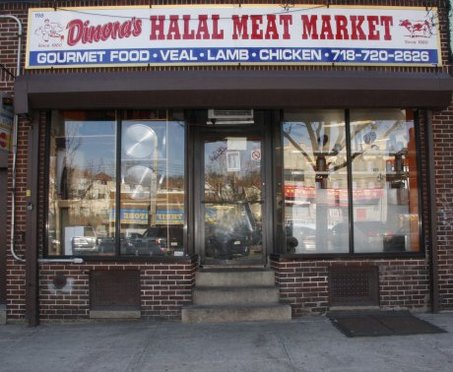
Dinora’s Halal Meat Market, Stapleton, Staten Island
I can’t say how this would scale up in re the SNAP allotment for households of two or more, since the amount goes up, but doesn’t double, with each additional household member. It would have proved harder if I’d restricted myself to the then-average single person allotment of $140 (though, if I’d been in the SNAP program, I could have used the food-pantry option to compensate for that).
On the other hand, special dietary needs that I don’t have — for allergies, diabetes, etc. — might have made it difficult indeed to get by on even the maximum allotment. Finally, at the age of 69 (in 2013) I stood 5’6″ and weighed 125 pounds, my fighting weight for many years; had I been substantially larger, I’d likely have needed more fuel, as I would have if I performed manual rather than mental labor.
If I could eat well, by commonplace standards, on $180 a month, in one of the most expensive cities in the country, with relatively few food outlets from which to buy my food, I consider it a reasonable allotment for a healthy adult with no special needs anywhere in the U.S. Because some of what that amount purchases likely lasts for several months, an additional $150 per additional adult, and $125 per additional child, seems appropriate to me.
(Part 1 I 2)
•
This post supported by a donation from Mike Hazard.
•
 Special offer: If you want me to either continue pursuing a particular subject or give you a break and (for one post) write on a topic — my choice — other than the current main story, make a donation of $50 via the PayPal widget below, indicating your preference in a note accompanying your donation. I’ll credit you as that new post’s sponsor, and link to a website of your choosing. Include a note with your snail-mail address (or email it to me separately) for a free signed copy of my 1995 book Critical Focus!
Special offer: If you want me to either continue pursuing a particular subject or give you a break and (for one post) write on a topic — my choice — other than the current main story, make a donation of $50 via the PayPal widget below, indicating your preference in a note accompanying your donation. I’ll credit you as that new post’s sponsor, and link to a website of your choosing. Include a note with your snail-mail address (or email it to me separately) for a free signed copy of my 1995 book Critical Focus!
Election 2016: Image World (5a)
Part 1 of this post appears below; click here for Part 2. — A. D. C.]
•
Eating Well on Food Stamps
My wife Anna and stepson Jacky left on an extended trip to China on January 11, 2013, several years into the Great Recession. With their departure, I found myself shopping and cooking for one for the first time in quite a while. I’d never tracked my food costs previously, but with right-wing indignation over all such “entitlements” much in the news I decided to take the opportunity afforded by the absence of Anna and Jacky to see how well I could subsist by myself on the average SNAP allowance for a single person at that time, $140 a month — my version of the “food stamp challenge.”
$1 food stamp coupon, 1980
That doesn’t sound like much, especially in today’s economy. I had read and heard constantly about how difficult it is to eat — and especially to eat well, meaning not just pleasurably but in a healthy, nourishing way — on the standard SNAP allotment. Since I continue to work, and generate income, I decided not to rely entirely on that allotment, but — as many working people do — to augment it, by adding $40 a month, giving me a total of $180 monthly with which to work, an average of $6 per day.
•
Our neighborhood, Stapleton, on the North Shore of Staten Island (just a few blocks away from where a homicidal policeman killed Eric Garner in July of 2014), does not offer much in the way of shopping. It’s not a food desert, but it’s not a food oasis either. We have no bakery, only a few small grocery stores, and only a few specialty food stores (these mostly sell African, Caribbean, and Latin American items).
Western Beef, Bay Street, Staten Island
Within walking distance we have one mediocre supermarket, a Western Beef branch (with the emphasis on large portions of meat, as the name suggests); Bay Street Bazaar, a Mexican bodega; a then-recently opened branch of Deals (which closed this past January, soon to be replaced by a Family Dollar outlet) and a more recently opened branch of Family Dollar (soon to be replaced by a Dollar Express outlet), both of which offered a small assortment of packaged and frozen foods; and Dinora’s Meat Market, a small eastern European halal butcher which also sells olives, feta and other cheeses, Bulgarian yogurt, assorted canned, bottled, and packaged foods, plus a few other things.
A longer walk away there was a more upscale supermarket, the Waldbaum’s in Rosebank (recently closed, the fate of its site uncertain). Even further, ten minutes by bus, there’s Top Tomato, a better supermarket, and, across the street from it, Montalbano’s, selling Italian specialties. Half an hour away by bus in another direction, on Hylan Boulevard, there’s Tastebud’s, a health-food store. When they’re here, once every week or so Anna and Jacky head to Chinatown in Manhattan to stock up on tofu, frozen dim sum, Chinese veggies, and other items. Unless I happened to find myself in or near one of those areas, I decided, I’d restrict myself to what I could find and bring home on foot within a roughly six-block radius.
Waldbaum’s, Rosebank, Staten Island, closing, 2016
For those in the SNAP program, the neighborhood also offers three local food pantries plus City Harvest, which distributes free produce to those who qualify. One allows twice-weekly usage, the other two a once-a-month haul. My visits to these, for informational purposes, showed that one could stock up on staples there: flour, breakfast cereals, pasta, rice, fruit juices, canned soups and vegetables, dried beans and chickpeas, and fresh baked goods — including excellent bread. One of these, after its twice-weekly distribution sessions for SNAP recipients. puts the leftover fresh bread outside for anyone to take. Donated by such sources as Trader Joe’s and Whole Foods, this is the best bread in the neighborhood; I availed myself of it then, and have done so periodically ever since.
The pantries offered some fresh vegetables and fruits, mostly the least perishable: white and sweet potatoes, carrots, butternut squash, cucumbers, onions, apples. City Harvest did the same. I ran my experiment in winter; perhaps in warmer weather the offerings multiply, and include more fruits and green veggies.
•
We eat very well, by our own standards, enough so that we prefer our own cooking to restaurant food. But we prepare more elaborate meals to consume ensemble than any of us would when eating solo. Part of my test, then, involved seeing whether I could maintain a high quality for the meals without spending a lot of prep time on them. This would lead me to the inclusion of a few more frozen foods, and more use thereof, than usual.
Top Tomato, Rosebank, Staten Island
I established a simple set of ground rules. I’d track all my food consumption for three months, January 15-May 15, making a meal-by-meal list. I’d track all food purchases during that period. If I used a foodstuff that we already had in the larder, I’d treat it as if freshly purchased and opened, and log it in as such. Thus some of the meals might draw, in whole or in part, on previously purchased ingredients and materials, but their cost would get ascribed to those months’ budget. (Coincidentally, at the time Anna and Jacky left on their trip we had used up almost all previously prepared dishes — extra portions of stews and soups that we’d frozen. So I had no MREs whose cost I could not ascribe.)
By the same token, I bought items during that period that lasted and got used well past the end date of my experiment, but whose full cost I logged in on my spreadsheet. So I erred on the side of full payment for everything used in that period, even if previously purchased, as well as everything purchased during that period, even if it didn’t get entirely used up.
Of course, you have to have access to a home garden, as I do — or a plot in a community garden, or a rooftop or terrace for planter gardening, or a sunny, protected corner of a vacant lot — to take advantage of that SNAP option. Similarly, this experiment assumes access to a kitchen with a range and oven, a refrigerator/freezer, a coffeemaker, a toaster, a microwave, a blender, a food processor, and a modest array of utensils and cookware — standard equipment in most kitchens today.
With those at my disposal, I discovered that, even in the relatively expensive urban environment of one of New York’s outer boroughs, a sum between the average and maximum monthly SNAP allotment at that point ($140-200) could provide sufficient healthy food for a reasonably active adult with no special needs who shops carefully and prepares his own meals at home.
Dinora’s Halal Meat Market, Stapleton, Staten Island
I can’t say how this would scale up in re the SNAP allotment for households of two or more, since the amount goes up, but doesn’t double, with each additional household member. It would have proved harder if I’d restricted myself to the then-average single person allotment of $140 (though, if I’d been in the SNAP program, I could have used the food-pantry option to compensate for that).
On the other hand, special dietary needs that I don’t have — for allergies, diabetes, etc. — might have made it difficult indeed to get by on even the maximum allotment. Finally, at the age of 69 (in 2013) I stood 5’6″ and weighed 125 pounds, my fighting weight for many years; had I been substantially larger, I’d likely have needed more fuel, as I would have if I performed manual rather than mental labor.
If I could eat well, by commonplace standards, on $180 a month, in one of the most expensive cities in the country, with relatively few food outlets from which to buy my food, I consider it a reasonable allotment for a healthy adult with no special needs anywhere in the U.S. Because some of what that amount purchases likely lasts for several months, an additional $150 per additional adult, and $125 per additional child, seems appropriate to me.
(Part 1 I 2)
•
This post supported by a donation from Mike Hazard.
•